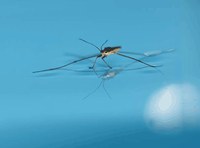Thesis: Peter REFKI
| When |
Dec 09, 2014
from 10:00 to 01:00 |
|---|---|
| Contact Name | Peter Refki |
| Add event to calendar |
|
On Tuesday 9th of December at 10:00am in Salle des Thèses Chantal Rabourdin-Combe (ENS, Monod campus) Peter REFKI from Abderrahman KHILA team () will defend his thesis entitled:
Hox genes and the evolution of adaptive phenotypes
Abstract:
 Populations are faced with selective pressures that act on certain traits resulting in phenotypic divergence. The evolution of adaptive morphological traits is often associated with changes in pre-existing structures. In semiaquatic insects, a dramatic growth of thoracic appendages is associated with their adaptation and efficient locomotion on the water surface. This particular leg allometry facilitated the exploitation of aquatic habitats, a restricted niche for their terrestrial relatives; and hence opens a new array of ecological opportunities. Additionally, the derived group of water striders has undergone further appendage modification, such that T2-legs are longer than T3-legs, a ground plan associated with the specialization to open water. Water striders have evolved a derived mode of locomotion through rowing on water. They move their mid-legs in simultaneous sweeping strokes for propulsion, and move their hind-legs in fine movements for orientation. Leg specification and elongation in semiaquatic insects happens during early embryogenesis as the newly hatching nymphs emerge with functional legs. The Hox transcription factor Ubx was found to be implicated in the reversal in leg ground plan. Nonetheless, the genetic mechanisms underlying these leg adaptive changes are still poorly understood. The presented thesis investigates these questions through two main goals: first, to uncover the genes and pathways implicated in the development and dramatic elongation of the legs; second, to examine the dynamics of Hox control responsible for the reversal in leg ground plan characteristic of water striders.
Populations are faced with selective pressures that act on certain traits resulting in phenotypic divergence. The evolution of adaptive morphological traits is often associated with changes in pre-existing structures. In semiaquatic insects, a dramatic growth of thoracic appendages is associated with their adaptation and efficient locomotion on the water surface. This particular leg allometry facilitated the exploitation of aquatic habitats, a restricted niche for their terrestrial relatives; and hence opens a new array of ecological opportunities. Additionally, the derived group of water striders has undergone further appendage modification, such that T2-legs are longer than T3-legs, a ground plan associated with the specialization to open water. Water striders have evolved a derived mode of locomotion through rowing on water. They move their mid-legs in simultaneous sweeping strokes for propulsion, and move their hind-legs in fine movements for orientation. Leg specification and elongation in semiaquatic insects happens during early embryogenesis as the newly hatching nymphs emerge with functional legs. The Hox transcription factor Ubx was found to be implicated in the reversal in leg ground plan. Nonetheless, the genetic mechanisms underlying these leg adaptive changes are still poorly understood. The presented thesis investigates these questions through two main goals: first, to uncover the genes and pathways implicated in the development and dramatic elongation of the legs; second, to examine the dynamics of Hox control responsible for the reversal in leg ground plan characteristic of water striders.
Keywords:
Hox genes, Adaptation, Allometry, Morphological evolution, Ubx, Water striders



